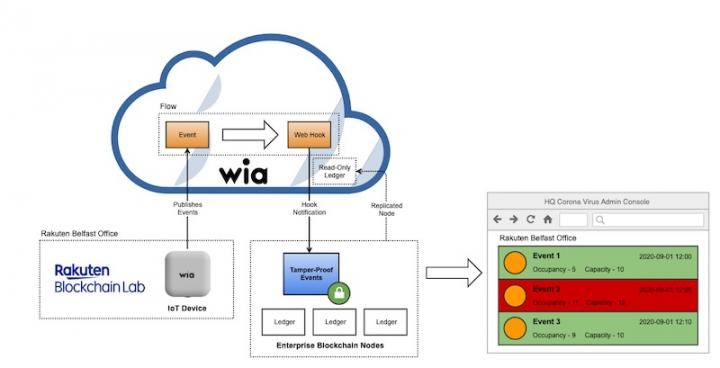
Belfast-based Rakuten Blockchain Lab, recently collaborated with Dublin based Smart Building startup, Wia to build a “Secure Blockchain Occupancy Management” proof of concept (PoC)
The world has changed. Restrictions placed on the movement of people have disrupted economic activity across the world as measures to control the coronavirus have been rolled out.
By midsummer, we were told that life was slowly returning to normal, whatever that means. If you've been left with feelings of anxiety and afraid to leave your home, you are not alone. It is very clear that whilst teams around the world work on an effective vaccine, we need to learn to live with COVID-19. We need to maintain a functioning economy by enabling people to work safely and keeping businesses in operation while living with the pandemic. Business owners and organisation leaders need to help employees, stakeholders, and customers through this crisis. Critical to a timely and sustainable recovery is TRUST.
One way to build trust as it relates to COVID-19 is to be open and transparent about the practices and procedures a business or organisation has implemented to meet the Government's public health advice. Physical distancing is one of the measures mandated by the authorities. This applies to businesses such as shops and restaurants as well as the office environment. Following the health advice on occupancy typically relies on low-fidelity solutions such as guidance posters, physical barriers, and in some cases dedicated staff to ensure no more than the permitted number of people can enter a store.
Businesses sign up to initiatives such as the Failte Ireland COVID-19 Safety Charter to demonstrate that they are taking the appropriate measures. If you had a higher level of trust that a business was adhering to social distancing guidelines, would you feel more confident about going there to eat or shop? Using a combination of Internet of Things (IoT) and Blockchain technologies, it is already possible to deliver a much more effective and trustworthy solution to this challenge.
The Internet of Things (IoT) is a network of devices (things) that are embedded with software and sensors allowing them to connect and exchange data between themselves and other systems using a network such as WiFi (internet). IoT sensors are quickly becoming a reality of the modern digital workplace. They’re the fabric that connects various technologies and allows us to gather valuable data about how employees interact with their environment. Occupancy sensors measure the occupancy of workspaces and conference rooms. While motion sensors are primarily used for security, occupancy sensors are used more often to collect real-time data about space utilisation.
A blockchain is a decentralised, distributed electronic database shared across a public or private network. Every transaction in a blockchain database is shared among several users (nodes), each one verifying that the database is accurate and preventing unauthorised transactions from being completed. As a result of how the records are written and confirmed on the blockchain, it becomes extremely difficult to tamper with them as it would necessitate compromising (hacking) the majority of the nodes in the network.
Belfast-based Rakuten Blockchain Lab, recently collaborated with Dublin based Smart Building startup, Wia to build a “Secure Blockchain Occupancy Management” proof of concept (PoC). Occupancy data collected from IoT Sensors located in business premises or an office is sent to Wia Cloud which triggers events that are written off to a tamper-proof ledger on a distributed blockchain.
These events represent actual occupancy versus maximum occupancy for the space being monitored and an event is recorded each time the occupancy level changes. The blockchain records can subsequently be accessed independently by organisations with permission to retrieve details of the occupancy related events. As these records are tamperproof, they provide a greater level of trust to the various stakeholders, such as employees and customers.
Both Wia and Rakuten Blockchain Lab brought core aspects of their existing technology to this PoC, which allowed it to be developed in a very short timeframe. Wia offers a cloud platform to which IoT devices can be connected to as well as an event and workflow engine that supports integration to other 3rd party applications. Rakuten Blockchain Lab has an established Enterprise Blockchain Platform which includes a service that allows events to be written to a tamper-proof ledger. The following diagram illustrates the core components and the flow of data.

In this PoC, door flow sensor information was used to create the event records representing employees of Rakuten Blockchain Lab entering and leaving the office, but the solution extends to any type of information coming from any type of IoT devices. Advanced occupancy sensors that track the number and movement of people within an area or room as well as sensors providing air quality measurements would enhance the view of COVID-19 compliance and help further build trust with customers and employees.
The compliance records on the ledger could be made available to travel, restaurant, and event booking sites via API to give customers a view on the occupancy (and other) data for the venue they are planning to visit.
Rakuten Blockchain Lab and Wia are excited about the possibilities of combining these two powerful technologies and look forward to getting feedback from existing and prospective Wia clients. Rakuten Blockchain Lab is also hoping to extend the Secure Blockchain Occupancy Management PoC to other Rakuten Europe offices to meet the internal compliance requirements as employees begin to return to the office.
This article first appeared in the 'Future Tech' edition of the Sync NI magazine and it can be found here.